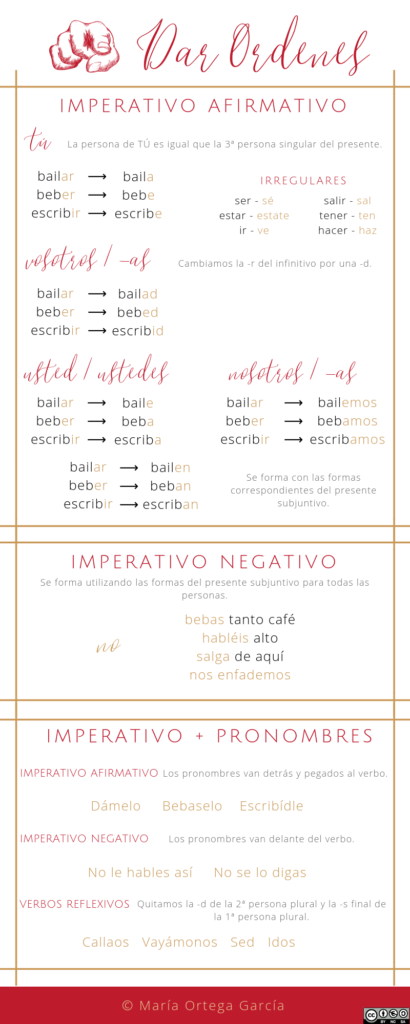How to give commands or instructions in Spanish?
The most common way of doing so is with the Imperative form. Of course, you can always use the polite indirect question like: ¿Puedes hacerme un café por favor? (Can you make a coffee for me, please?) or ¿Te importaría cerrar la puerta? (Would you mind closing the door?)
But the truth is that Spanish is quite a direct language as their speakers are. We tend to be spare in words whenever we can. That is why we love the imperative to give commands or instructions rather than a “convoluted” question 😜.
How to build the imperative?
The first thing you need to know is that there are five forms.
Tú
Vosotros
Usted
Ustedes
Nosotros
Also, you need to know that we can give negative commands. But let’s start with the affirmative commands, shall we?
Affirmative Imperative
The form of TÚ (2nd person singular) looks the same as the form of ÉL/ELLA (3rd person singular) of the Presente.
Bailar ⟶ Baila
Beber ⟶ Bebe
Escribir ⟶ Escribe
The forms of USTED and USTEDES looks the same as the corresponding form of Presente Subjuntivo.
Bailar ⟶ Baile Bailen
Beber ⟶ Beba Beban
Escribir ⟶ Escriba Escriban
The form of VOSOTROS the “-r” in the Infinitive changes in a “-d”.
Bailar ⟶ Bailad
Beber ⟶ Bebed
Escribir ⟶ Escribid
The form of NOSOTROS looks the same as the corresponding form of Presente Subjuntivo.
Bailar ⟶ Bailemos
Beber ⟶ Bebamos
Escribir ⟶ Escribamos
IRREGULAR VERBS IN IMPERATIVE
ser ⟶ sé hacer ⟶ haz
estar ⟶ estate poner ⟶ pon
ir ⟶ ve salir ⟶ sal
venir ⟶ ven tener ⟶ ten
Negative Imperative
The negative imperative is built using the corresponding forms of the Presente Subjuntivo and “NO” in front of the verb.
No bebas tanto café (Don’t drink so much coffee).
No habléis alto (Don’t speak out loud).
No salga de aquí (Don’t leave).
No nos enfademos (Let’s not get angry).
Imperative with Pronouns
What to do with the pronouns when we are giving a command?
If the command is affirmative, the pronouns will go after the verb and stuck to it forming one word.
Dámelo (Give it to me)
Bébaselo (Drink it)
Escribidle (Write to him)
If the command is negative then, we keep the regular order having the pronoun before the verb (separated from it).
No le hables así (Don’t speak to him like that).
No se lo digas (Don’t say it to him).
And if you are using a reflexive verb (those ending in “-se”) then you have to remove the “-d” from the form of vosotros, and the “-s” from the form of nosotros.
Callaos (not callados or callaros)
Vayámonos (not vayámosnos)
Sed (not ser)
Idos (not iros)

You might be interested...
Check out How to give instructions in Spanish to delve into this topic.
Also, if you are considering taking the DELE exam, I invite you to have a look at this levelling up self-pace online courses with practise and exercise



Your lesson on imperative keeps referring to Present Subjunctive. That’s so maddening. When you first start learning Spanish, you need to know imperative much more than you need subjunctive. Forcing people to learn subjective before imperative is just stupid.
The imperative negative is formed with the forms of the present subjunctive. I am not forcing anyone to learn subjunctive, but if someone wants to learn to give commands in both a positive (do this) and a negative form (don’t do this), then Subjunctive is necessary for the negative form.